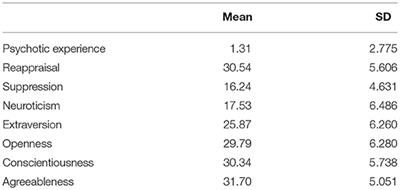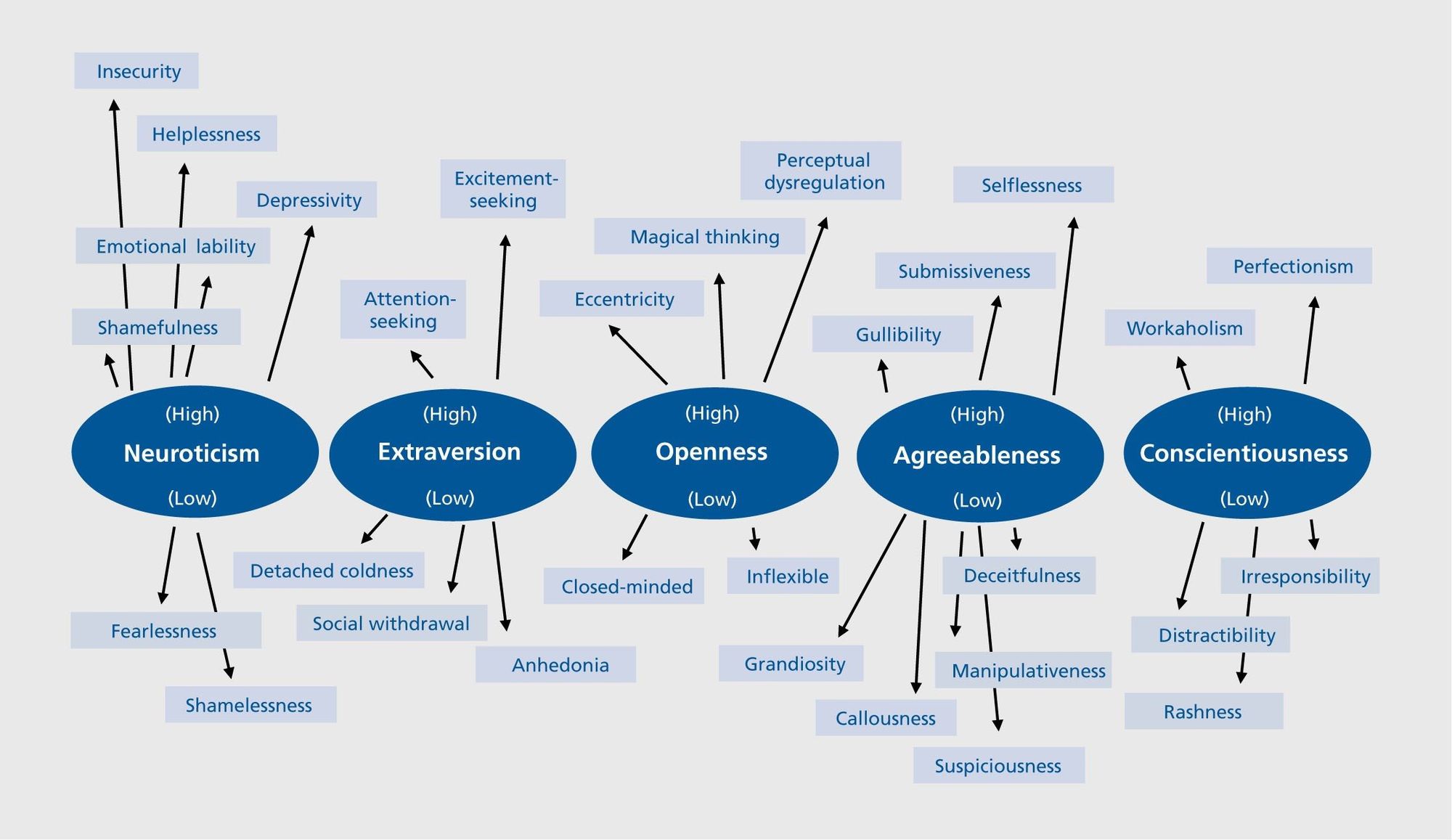The Big Five Inventory
The NEO Personality Inventory test (NEO-PI) is a psychometric assessment tool widely used by employers as a key part of their recruitment process and increasingly as an on-job assessment tool. Also known as the Big Five, OCEAN or CANOE, the personality model used by the NEO-PI test measures five aspects of the personality and has versions for adults, adolescents. Norms for the Big Five Inventory and other personality measures Published on October 17, 2012 by Sanjay Srivastava Every once in a while I get emails asking me about norms for the Big Five Inventory. The Big Five Inventory (BFI) The Big Five was started from the statistical study of responses to common personality elements. This test in specific is the most frequently used, being the most scientifically validated and the most acceptable personality model in academic psychology. Big Five Plus Personality Inventory (BigFive+) BIG FIVE+ is a personality assessment tool based on Big Five model of personality. Big Five is one of the most researched and cross culturally validated model of personality. BigFive plus includes 5 core dimensions as well as 2 supplementary dimensions. The Big Five Inventory. The Big Five Inventory (BFI) is a self-report inventory designed to measure the Big Five dimensions. It is quite brief for a multidimensional personality inventory (44 items total), and consists of short phrases with relatively accessible vocabulary. To learn more about the BFI, click.
Frequently Asked Questions
The Big Five Inventory (BFI) is a self-report inventory designed to measure the Big Five dimensions. It is quite brief for a multidimensional personality inventory (44 items total), and consists of short phrases with relatively accessible vocabulary.
Is the Big Five Inventory (BFI) in the public domain and available for use?
I hold the copyright to the BFI and it is not in the public domain per se. However, it is freely available for researchers to use for non-commercial research purposes. Please keep us posted on your findings.
Where do I get the Big Five Inventory (BFI)?
If you are interested in taking the BFI yourself, please visit this website, where you can take an online version of the scale that gives you instant feedback.
If you are interested in using the BFI for commercial purposes, please submit a request to ucbpersonalitylab@gmail.com. At this time, the BFI is for non-commercial uses only.
If you are interested in using the BFI for research purposes, please click [here],which will direct you to the BFI download page. We are trying to createa database for BFI users of publications, relevant findings, andtranslations of the BFI in an effort to make the scale more useful forusers. Thus, before downloading a copy of the BFI and the scoringinstructions, please complete a short survey to let us know a littlemore about who you are and why you want to use the measure. Allinformation will be kept strictly confidential.
How should I reference the BFI?
You should reference these article in manuscripts using the BFI:
(1) John, O. P., Naumann, L. P., & Soto, C. J. (2008). Paradigm Shift to the Integrative Big-Five Trait Taxonomy: History, Measurement, and Conceptual Issues. In O. P. John, R. W. Robins, & L. A. Pervin (Eds.), Handbook of personality: Theory and research (pp. 114-158). New York, NY: Guilford Press.
Big 5 Personality Theory
(2) John, O. P., Donahue, E. M., & Kentle, R. L. (1991). The Big Five Inventory--Versions 4a and 54. Berkeley, CA: University of California,Berkeley, Institute of Personality and Social Research.
(3) Benet-Martinez, V., & John, O. P. (1998). Los Cinco Grandes across cultures and ethnic groups: Multitrait multimethod analyses of the Big Five in Spanish and English. Journal of Personality and Social Psychology,75, 729-750.
How do I score the BFI?
Scoring instructions and SPSS syntax are downloadable from this website after completing the survey.
Are there norms for the BFI?
Thereis no official BFI manual with published norms. However, the followingpaper contains means from age 20 to age 60. You might want to look atit (download here)for an American sample; scores were converted to POMP (percentage ofmaximum possible) metric and graphed by gender and age for each BigFive dimension.Srivastava, S., John, O. P., Gosling, S. D., & Potter, J. (2003).Development of personality in early and middle adulthood: Set likeplaster or persistent change? Journal of Personality and SocialPsychology, 84, 1041-1053

Is there a shorter version of the BFI available?
Yes, there is an abbreviated 11-item version available here. However, given that the entire BFI consists of only 44 very short phrases and takes only 5 minutes to complete, we do not recommend using the short 11-item version unless there are exceptional circumstances.
Is there a version with language appropriate for children?
Yes, there is a version of the BFI where items with wording difficult for children have been modified.This version has also been adapted so that parents may fill it out for their children. Both versions are available after completing the survey.
Scoring The Big 5 Personality Inventory
Is the BFI available in other languages?
Yes, the BFI has been translated into the following languages:
Chinese

Dutch
German (BFI-10 only)
English

Hebrew
Italian
Lithuanian
Portugese
Spanish
Swedish
Can I translate the BFI so that I may use it for research purposes?
If you translate the BFI, an expert bilingual (someone who is American or has lived in the U.S.A.) should perform back-translation procedures with your newly-translated version. In other words, after you have translated the BFI into the new language, an expert bilingual should translate it back into English. Next, you should compare that back-translated English version to the original English version of the BFI. Please send us a copy of theversion that you are going to use so that we may add it to our collection.
Finally,it's much more important to capture the *total meaning* of the itemthan to translate any of its parts literally. For example, thetranslation of 'calm' into German often comes out as 'ruhig' but thatcould be N- as well as E- (as in still, quiet--even in English, 'calmwaters' are still and quiet, too!). So, an N item that has calm as apart is better translated into German using the negation 'nichtnervoes' than the more literal translation 'ruhig'.
Why are there multiple descriptors for some BFI items?
Forseveral items, such as 'being relaxed, handles stress well, the typicalunderstanding would be that the second phrase provides an elaborationof the first concept, so its understood as 'being relaxed, in the senseof being good at handling stress'. Specifically, 'relaxed' is typicallya low-Neuroticism item and means 'not anxious, not easily upset orstressed out.' But some people might misunderstand 'relaxed' to mean'easy-going, having fun' which would be an high-Extraversion item.Thus, to rule out this misinterpretation, we use 'handles stress well'to elaborate what we mean by 'being relaxed'.
How do you handle missing items?
There are different approaches in the literature, varying incomplexity. If a lot of item responses are missing, you may not want touse that person's scores. With only a few responses missing (6 orless), I try to use either the response to the closest synonym(similar) item or I compute the scale score (as an average itemresponse) without the missing item(s) and then use that score (roundedto an integer) as the substitute item score (when you do that, becareful not to get confused with reverse items).Given the fact that it is a five pt Likert scale, there are bound to besome middle (3) responses given, especially if participants becomefatigued. How do you handle these 3 responses? Are they discarded? Orare they counted toward the total score?
I almost always permit middle responses (3)--when research participantsare reasonably motivated, they use '3' when appropriate--on some items,people are just 'in the middle.' These scores get simply added into theoverall score. Remember, this is truly a dimensional response scale,not a 'true or false' questionnaire! In fact, on some items, responding'3' is actually very diagnostic; for example, responding '3' thereverse Agreeableness item 'Starts quarrels with others' means theparticipant is admitting to considerable disagreeableness (the majorityof individuals answer 2 or even 1). So, unless there are lots of 3responses, I would not worry about it.:max_bytes(150000):strip_icc()/2795422-article-the-big-five-personality-dimensions-5a9083fb6edd650036603137.png)
Hasanyone used the scale without response 3 (neither agree or disagree)?i.e. use only the remaining 4 item scale to force respondents to choosean answer? Have there been any psychometrics done on this?
You areimplying that you will give the BFI in an interview format--will you?If so, you could give an instruction that says 'first, consider whetheryou agree with this item, or disagree--choose one way.” Then have themrate *how much* they agree (strongly or a little) or disagree (stronglyor a little). And tell them that they should/can respond 'neither agreenor disagree, right in the middle' only in those rare instances whenthey are really right in the middle.If the BFI is self-administered, in that participants read the items bythemselves and record their answers in writing (the way we usuallyadminister the BFI), then yes, you could simply give the scale asranging from 1 to 4, with the middle-response option omitted. If youhave strong reasons to do that, it's ok with me, but you will end upsacrificing the opportunity to compare your means and SDs to otherresearch, all of which has used the standard 5-point scale. If theproblem is fatigue-related, I would rather have them take a littlebreak!
Should I use the 54-item version?
 You seem to be using a very early version of the BFI; 10 items are notscored on any of the scales. The following materials refer to the44-item version, all of which are included in the 54-item version. Justselect those items and follow the scoring for those 44. Ignore theother 10 items. If the BFI is administered routinely at yourinstitution, you may want to update the questionnaire and use the44-item final version.
You seem to be using a very early version of the BFI; 10 items are notscored on any of the scales. The following materials refer to the44-item version, all of which are included in the 54-item version. Justselect those items and follow the scoring for those 44. Ignore theother 10 items. If the BFI is administered routinely at yourinstitution, you may want to update the questionnaire and use the44-item final version.Icannot locate the John & Donahue, 1998, The Big Five Inventory:Studies of reliability and validity article referenced inBenet-Martinez & John 1998. Was it published?
No, it was notpublished. Please refer to Rammstedt & John 2007, Measuringpersonality in one minute or less: A 10-item short version of the BigFive Inventory in English and German. Journal of Research inPersonality, 41, 203-212. This article focuses on a shorter 10-itemversion that includes information on external validity via peer ratingsfor the full, 44-item BFI as well. Note that we do not recommend usingthe short 10-item version unless there are exceptional circumstances.Where can I learn more about the Big Five dimensions of Personality?
For an introduction to the conceptual and measurement issues surrounding the Big Five personality factors, a good place to start is the recent John, Naumann, & Soto (2008)Handbook of Personality chapter.
The chapter covers a number of important issues including the scientific origins and history of the Big Five, theoretical accounts of the Big Five, and comparisons of different measurement instruments. The chapter also includes a conceptual and empirical comparison of three measurement instruments: the Big Five Inventory (BFI), Costa and McCrae's NEO Five Factor Inventory (NEO-FFI), and Goldberg's set of 100 trait-descriptive adjectives.Thereis no one-size-fits-all measure, but the chapter includes ourrecommendations on which instrument(s) you should use for differentapplications.